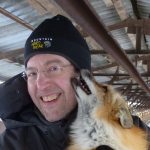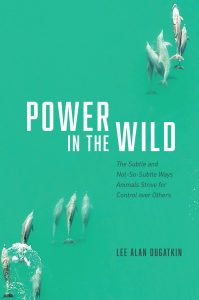5 Questions for Lee Alan Dugatkin, author of “Power in the Wild: The Subtle and Not-So-Subtle Ways Animals Strive for Control over Others”
From the shell wars of hermit crabs to the machinations of mongooses, power struggles in the animal kingdom are as diverse as they are fascinating. In Power in the Wild, behavioral ecologist and brilliant storyteller Lee Alan Dugatkin illuminates their surprising range and connections. Beloved for his bestselling book How to Tame a Fox, coauthored with Lyudmila Trut, Dugatkin here links up the stories of thirty-three species across six continents, investigating the unifying influence of power on the lives of dolphins, bonobos, field mice, cichlid fish, copperhead snakes, meerkats, and more. Nor are we humans invulnerable to Dugatkin’s magnificently intricate melodrama: his tales of the researchers studying power in animals are full of unexpected pitfalls, twists and turns, serendipity, and the pure joy of scientific discovery. We spoke with Dugatkin to learn a little more about the inspiration for this book, some of his research experiences, and the plans for his next manuscript.
How did you wind up in your field, and what do you love about it?
Some of my colleagues in animal behavior can show you pictures of themselves birding when they were three years old. For me, the path to studying evolution and animal behavior was much more circuitous. I grew up in New York City’s Stuyvesant Town, and my interactions with animals in “nature” centered on squirrels and pigeons. When I was an undergraduate, I had no idea what I wanted to be when I grew up. I always had an interest in American history, so I decided to major in that. About a year before I graduated, a friend of mine told me about a course he was taking in animal behavior and suggested I take a look at the textbook from the class. I did, and I immediately fell in love with the field. The notion of using evolutionary thinking to understand behavior hit me like a bolt of lightning. From that point on I’ve never looked back. I’ve had a chance to do research on everything from power to cooperation and from altruism to cultural transmission in animals, and I’ve enjoyed every minute of it. About fifteen years ago, I married my early interest in history with my passion for the study of evolution and behavior and began doing work on the history of science. That too has proved enormously satisfying.
In one of your previous books, How to Tame a Fox (and Build a Dog), you explored one groundbreaking experiment in Siberia and what it revealed about the domestication of dogs. In Power in the Wild, you set out to understand power in dozens of species, poking, probing, and working with researchers everywhere from Africa and Asia to Australia, the Americas, and Europe. Why that approach?
The silver fox domestication experiment is a special case. It was an honor to have Lyudmila Trut, who has led that experiment for sixty years, as my coauthor. Together we could write about every nook and cranny of that pathbreaking work, from genetics and domestication to the political backstory, which involved researchers on this project displaying courage and persistence of almost superhuman proportions. For Power in the Wild, I thought it was essential to search all over the planet, with the aim of finding studies that help us understand the role that power plays in shaping animal societies. My colleagues who study power all over the world were beyond generous with their time and knowledge as I wrote the book.
While you were working on this project, what did you learn that surprised you the most?
I knew going into the project that the quest to attain and maintain power in nonhumans was subtle and complex, but I didn’t realize just how complex and how subtle. The extent to which natural selection has shaped strategies for attaining power is mindboggling. Little blue penguins spy on rivals for power, ravens display power in different ways depending on their audience, hyenas form coalitions to rise in rank, cuttlefish use their mastery of camouflage to climb the power ladder, and so much more. Animal behaviorists are piecing this together to build an integrative, conceptually powerful, model of the evolution of power.
Where will your research and writing take you next?
In terms of research, one of my students, Caroline Driscoll, and I are doing experimental work on empathy in nonhumans. Book writing–wise, I am in the middle of penning a new trade book (for The University of Chicago Press J) on the importance of social networks in nonhumans. The work on this subject is so rich and cutting-edge, that it is a pleasure to do a deep dive into it.
What’s the best book you’ve read lately?
I loved Ed Dolnick’s new book, The Writing of the Gods: The Race to Decode the Rosetta Stone(Scribner, 2021). It’s both meticulously researched and a pageturner, stock full of wonderful tales of cryptography and linguistics. I’m currently reading David Haskell’s delightful new book, Sounds Wild and Broken: Sonic Marvels, Evolution’s Creativity, and the Crisis of Sensory Extinction(Viking Press, 2022). David is a modern-day Thoreau and this book has me thinking about natural soundscapes and all they represent in a completely new way.

Lee Alan Dugatkin is a behavioral ecologist and historian of science in the Department of Biology at the University of Louisville. Among his ten books are How to Tame a Fox (and Build a Dog), Mr. Jefferson and the Giant Moose, and Principles of Animal Behavior, all published by the University of Chicago Press.
Power in the Wild is available now! Find it on our website, online at any major booksellers, or at your local bookstore.
